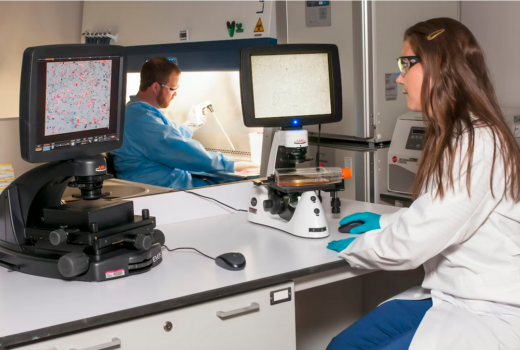Titan, broer van de Aarde
Kille broeder
Two NASA researchers, Rosaly Lopes and Robert M. Nelson of the Jet Propulsion Laboratory in Pasadena, California, are reporting that weather and geology have very similar actions on Earth and Titan — even though Saturn’s moon is, on average, 100 degrees C (212 degrees F) colder than Antarctica.
The researchers are also reporting a tantalizing clue in the search for life: Titan hosts chemistry much like pre-biotic conditions on Earth. Wind, rain, volcanoes, tectonics and other Earth-like processes all sculpt features on Titan’s complex and varied surface. The many lakes that pepper the northern polar latitudes, with a scattering appearing in the south as well, are thought to be filled with liquid hydrocarbons, such as methane and ethane. On Titan, methane takes water’s place in the hydrological cycle of evaporation and precipitation (rain or snow) and can appear as a gas, a liquid and a solid. Methane rain cuts channels and forms lakes on the surface and causes erosion, helping to erase the meteorite impact craters that pockmark most other rocky worlds, such as our own Moon and the planet Mercury.
Vulkanen in Hotei
Another Cassini instrument called the Visual and Infrared Mapping Spectrometer (VIMS) had previously detected an area, called Hotei Regio, with a varying infrared signature, suggesting the temporary presence of ammonia frosts that subsequently dissipated or were covered over. Although the ammonia does not stay exposed for long, models show that it exists in Titan’s interior, indicating that a process is at work delivering ammonia to the surface. RADAR imaging has indeed found structures that resemble terrestrial volcanoes near the site of suspected ammonia deposition.
Nelson said new infrared images of the region, also presented at the IAU, “provide further evidence suggesting that cryovolcanism has deposited ammonia onto Titan’s surface. It has not escaped our attention that ammonia, in association with methane and nitrogen, the principal species of Titan’s atmosphere, closely replicates the environment at the time that life first emerged on Earth. One exciting question is whether Titan’s chemical processes today support a prebiotic chemistry similar to that under which life evolved on Earth?”
Ga mee naar Titan!
Wilt u zelf een kijkje nemen op Titan? Dat kan, want verre reizen waren nog nooit zo goedkoop. Vlieg met ScienceGuide dezer weken gratis mee naar Titan.
The Cassini spacecraft has several flyby tours scheduled for the next few months. You can travel for FREE! just by following the the Cassini website. Thrill with some of the closest flybys ever of mystery moon Titan. As a special bonus, if you book today, you can experience Saturn’s solar equinox, as in August the sun crosses from the southern hemisphere to the north. Wonderful worlds are beckoning. It’s a worry free vacation.
Meest Gelezen
Vrouwen houden universiteit draaiende, maar krijgen daarvoor geen waardering
Wederom intimidatie van journalisten door universiteit, nu in Delft
Hbo-docent wil wel rolmodel zijn, maar niet eigen moreel kompas opdringen
‘Burgerschapsonderwijs moet ook verplicht worden in hbo en wo’
Raad van State: laat taaltoets nog niet gelden voor hbo-opleidingen


